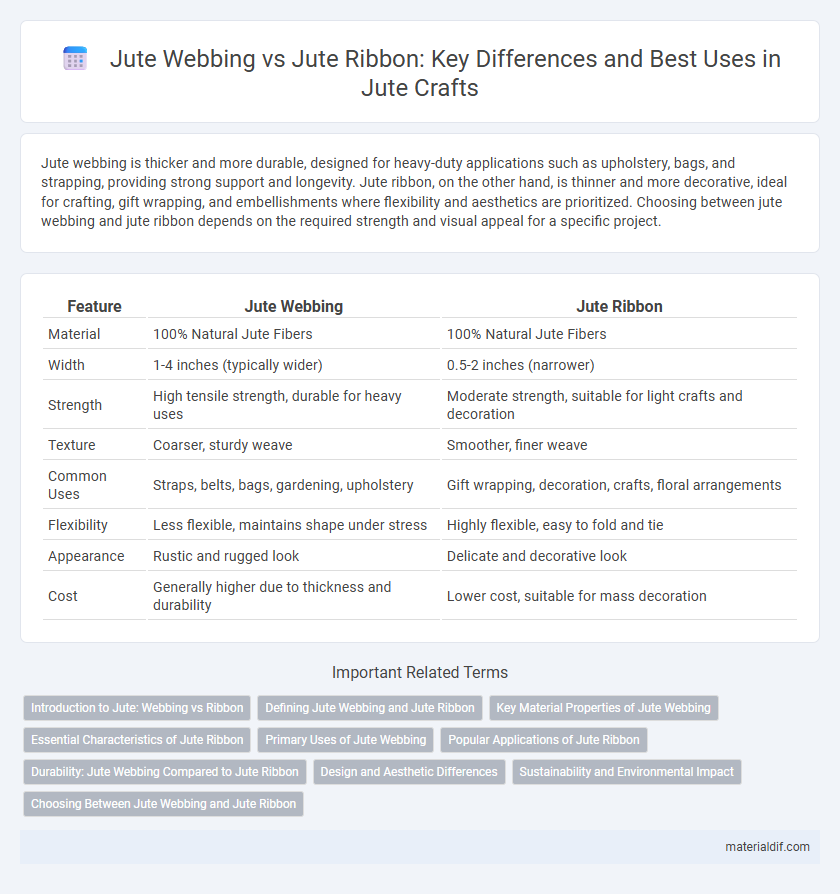Jute webbing is thicker and more durable, designed for heavy-duty applications such as upholstery, bags, and strapping, providing strong support and longevity. Jute ribbon, on the other hand, is thinner and more decorative, ideal for crafting, gift wrapping, and embellishments where flexibility and aesthetics are prioritized. Choosing between jute webbing and jute ribbon depends on the required strength and visual appeal for a specific project.
Table of Comparison
| Feature | Jute Webbing | Jute Ribbon |
|---|---|---|
| Material | 100% Natural Jute Fibers | 100% Natural Jute Fibers |
| Width | 1-4 inches (typically wider) | 0.5-2 inches (narrower) |
| Strength | High tensile strength, durable for heavy uses | Moderate strength, suitable for light crafts and decoration |
| Texture | Coarser, sturdy weave | Smoother, finer weave |
| Common Uses | Straps, belts, bags, gardening, upholstery | Gift wrapping, decoration, crafts, floral arrangements |
| Flexibility | Less flexible, maintains shape under stress | Highly flexible, easy to fold and tie |
| Appearance | Rustic and rugged look | Delicate and decorative look |
| Cost | Generally higher due to thickness and durability | Lower cost, suitable for mass decoration |
Introduction to Jute: Webbing vs Ribbon
Jute webbing and jute ribbon both derive from the natural jute fiber known for its strength and eco-friendliness, but they serve different purposes due to their unique textures and widths. Jute webbing is thicker, stronger, and commonly used in upholstery, bags, and heavy-duty applications, while jute ribbon is finer and primarily favored for decorative crafts, gift wrapping, and floral arrangements. Both offer biodegradable and sustainable options, appealing to environmentally conscious consumers seeking versatile natural fiber products.
Defining Jute Webbing and Jute Ribbon
Jute webbing consists of flat, woven strips of jute fiber designed for heavy-duty applications such as upholstery, bag handles, and strapping due to its strength and durability. Jute ribbon is a narrower, decorative strip made from jute, often used for crafts, gift wrapping, and floral arrangements to add a rustic, natural aesthetic. Both materials leverage the eco-friendly and biodegradable properties of jute fiber but serve distinct functional and ornamental purposes.
Key Material Properties of Jute Webbing
Jute webbing is characterized by its high tensile strength, coarse texture, and excellent breathability, making it ideal for heavy-duty applications such as upholstery and load securing. Unlike jute ribbon, which is finer and smoother, jute webbing offers enhanced durability and abrasion resistance due to its thicker weave and reinforced fibers. The natural lignin content in jute webbing provides moisture resistance and dimensional stability, crucial for outdoor and industrial uses.
Essential Characteristics of Jute Ribbon
Jute ribbon is characterized by its smooth texture, narrow width, and refined finish, making it ideal for decorative and crafting purposes. Unlike broader, coarser jute webbing used for heavy-duty applications, jute ribbon offers flexibility and aesthetic appeal while maintaining the natural strength and eco-friendly properties of jute fiber. Its lightweight and delicate structure allow for easy manipulation in gift wrapping, fashion accessories, and interior decor.
Primary Uses of Jute Webbing
Jute webbing is primarily used in upholstery, furniture manufacturing, and securing heavy loads due to its strength and durability. Unlike jute ribbon, which is mainly decorative for crafts and gift wrapping, jute webbing provides essential support in industrial applications and eco-friendly packaging. Its robust weave makes it ideal for reinforcing chairs, sofas, and transporting goods safely.
Popular Applications of Jute Ribbon
Jute ribbon is widely used in gift wrapping, floral arrangements, and craft projects due to its smooth texture and decorative appeal. Its flexibility and natural rustic look make it ideal for home decor, event decorations, and sustainable packaging solutions. Unlike jute webbing, which is thicker and used for heavy-duty straps, jute ribbon excels in aesthetic and lightweight applications.
Durability: Jute Webbing Compared to Jute Ribbon
Jute webbing exhibits superior durability compared to jute ribbon due to its thicker weave and reinforced structure, making it ideal for heavy-duty applications such as upholstery and bag handles. The tightly woven fibers in jute webbing resist fraying and wear, while jute ribbon, being thinner and more decorative, is prone to quicker deterioration under stress. This strength difference is critical when selecting materials for projects requiring long-lasting support and resilience.
Design and Aesthetic Differences
Jute webbing features a thicker, more durable weave designed for heavy-duty applications like upholstery and bags, offering a rustic, coarse texture that emphasizes strength and natural appeal. In contrast, jute ribbon is narrower and often more finely woven or braided, providing a softer, more refined aesthetic ideal for decorative purposes such as gift wrapping and crafts. The design of jute webbing prioritizes functionality and ruggedness, while jute ribbon focuses on delicate patterns and visual elegance.
Sustainability and Environmental Impact
Jute webbing offers superior durability and strength compared to jute ribbon, making it ideal for heavy-duty sustainable applications like eco-friendly packaging and furniture straps. Both jute webbing and jute ribbon are biodegradable and renewable, produced from the same natural fibers that absorb high amounts of carbon dioxide during growth, contributing to carbon footprint reduction. While jute ribbon is more decorative and used in gift wrapping, jute webbing supports sustainability goals through its longer lifespan and minimal ecological impact in industrial and agricultural uses.
Choosing Between Jute Webbing and Jute Ribbon
Choosing between jute webbing and jute ribbon depends on the intended use, as jute webbing offers superior strength and durability ideal for heavy-duty applications like bag handles and belts. Jute ribbon, being thinner and more flexible, is better suited for decorative purposes, gift wrapping, and crafting projects that require a softer texture. Evaluating the required load-bearing capacity and aesthetic appeal helps determine the most effective option for specific jute material needs.
Jute webbing vs Jute ribbon Infographic

 materialdif.com
materialdif.com